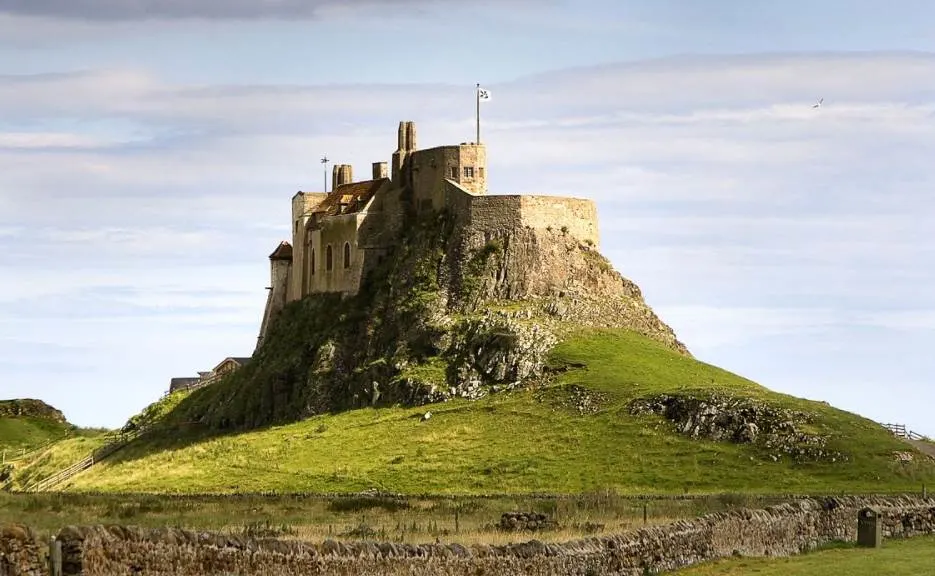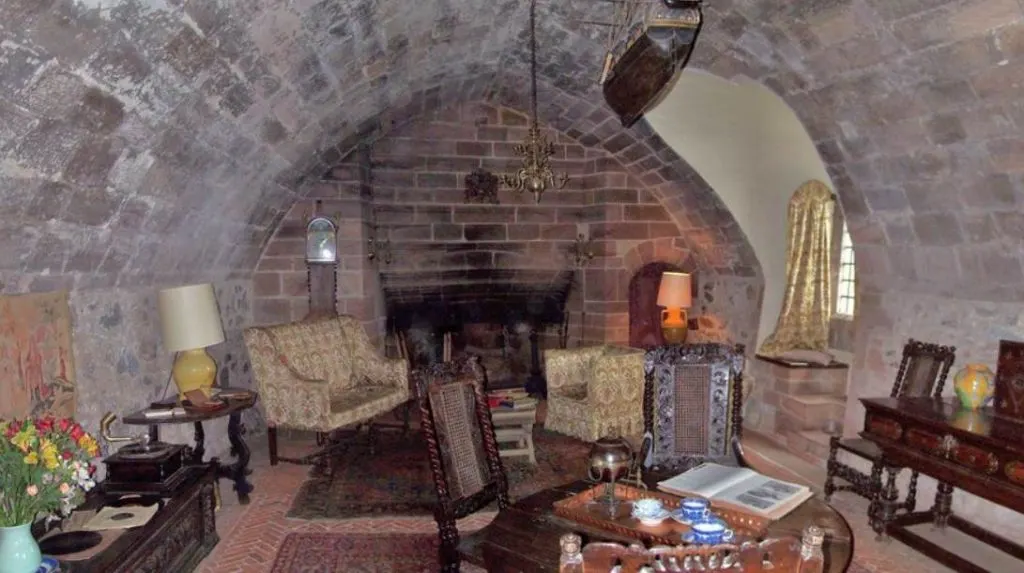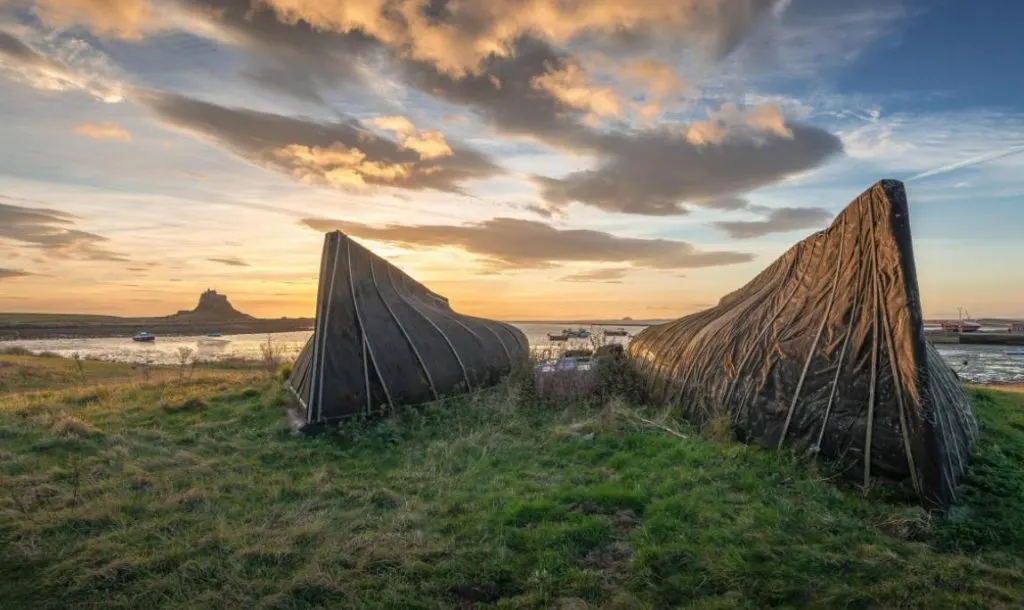If you want to enjoy a healthy hike while at the same time discovering one of the most amazing castles in England, then you have to head over to the northeast of the country.
In this article, we’ll take a closer look at some of the most interesting facts about Lindisfarne Castle, a 16th-century fortification that serves a completely different purpose today.
1. It’s located on a tidal island just off the coast of Northumberland
Lindisfarne Castle is a fortified complex that stands majestically on a tidal island known as “Holy Island.” It’s not too far away from another famous castle in the area called Bamburgh Castle which is located just to the south.
The castle is located just off the coast of Northumberland, a county in the utmost northeastern part of England. The closest town in the area is situated just northwest of Holy Island and is called Berwick-upon-Tweed.
This town is located just 4 kilometers (2.5 miles) away from the border with Scotland, something that instantly explains why a castle was built here. It’s also the northernmost town in all of England.

2. The original fortification replaced a priory on this location
The first thing you’ll notice is that the castle is located in a somewhat elevated position. That’s because it was built on a whinstone hill, a dark-colored rock formation.
This hill is obviously a strategic position and has a name too as it’s referred to as “Beblowe Crag.” It’s here that a former monastery was located called Lindisfarne Priory.
This structure was demolished in the 16th century thanks to the “Dissolution of the Monasteries” between 1536 and 1541, an event initiated by King Henry VIII.

3. The castle wasn’t completed until the early 1570s
The original structure to replace the monastery was a small fort. This building project started around 1550 and the stones of the demolished monastery were used to build it.

As expected, it was built on the highest position of the small tidal island to provide a great view over both the land and the sea.
What’s remarkable is that this so-called “fort” wasn’t anywhere near the castle we see today until at least the late 1560s. It’s not until Elizabeth I (1533-1603) commissioned the expansion of it that work moved forward.
It was finally completed between 1570 and 1571, over 2 decades after the work had started.

4. It mostly served its purpose as a garrison of soldiers
Lindisfarne Castle was referred to as “the fort” for about 3 centuries. That’s mainly because it didn’t really serve as more than a depot for artillery and a lookout post to watch out for trouble.
The garrison that was stationed here must have been rather bored so they filled their days shooting the guns and watching the amazing sunsets.
Yes, it’s fair to conclude that the military history of the castle was rather quiet. Except for one uprising of Jacobite rebels during the 18th century during which they briefly controlled the castle, nothing noteworthy happened throughout its history.

5. It was transformed into a residence in the early 20th century
Edward Burgess Hudson (1854-1936), the man who founded the popular “Country Magazine” in 1897, discovered the castle in 1901 and quite literally fell in love with the place.
Even though it was seriously deteriorated by then after over 4 centuries of facing the harsh weather off the Northumberland Coast, it was still standing.
The wealthy businessman acquired the castle and hired renowned English architect Sir Edwin Landseer Lutyens (1869-1946) to transform the caste into a holiday residence.
This renovation project took place between 1903 and 1906 and many elements of the original castle were lost during this period. It served as a residence for over 7 decades and is now a popular tourist attraction in the region.

More interesting facts about Lindisfarne Castle
6. Even though the castle is located on a tidal island, it can be accessed from the mainland through a causeway. This is only possible at low tide, though, because this road is pretty much completely flooded otherwise.
The island isn’t as small as it initially appears to be as it has a length of 4.8 kilometers (3 miles) and a width of 2.4 kilometers (1.5 miles). At high tide, it covers an area of approximately 400 hectares (1,000 acres).
7. Holy Island is one of the main features inside the “Lindisfarne National Nature Reserve.” This remarkable piece of nature offers amazing views and the opportunity to see sea life such as seals, birds, and other wildlife.
There are also plenty of trails inside this nature preserve which makes it one of the most amazing places to hike in the northeastern part of England.

8. Before the castle was completed in the early 1570s, the purpose of the fort was already to store guns. Some of these guns included a wheel-mounted demi-culverin, 2 brass sakers, falconet, and another fixed demi-culverin.
The final construction phase cost £1191, the equivalent of over £626,000 today. While this seems a lot, especially because the place ended up being nothing more than a storage facility, this was still a low amount compared to other castles built around that time.
9. Not much of the original castle can still be seen following the renovation project conducted by Edwin Luytens in the early 20th century. The interior was designed in the Arts and Crafts style, a style considered to be the root of the modern decorative style.
The architect of the project ended up becoming world-famous, designing countless monuments and buildings all around the world. Luytens especially put his permanent mark on the city of Delhi in India, so much that “New Delhi” is sometimes referred to as “Luytens Delhi.”
10. The castle isn’t too far away from the Scottish capital of Edinburgh. One of the most remarkable facts about Lindisfarne Castle is that the architect during the early 20th century used upturned herring busses as sheds.
These remarkably repurposed structures ended up serving as the inspiration for the Scottish parliament building designed by Spanish architect Enric Miralles. The reviews about this structure, however, have been mixed to put it euphemistically.

